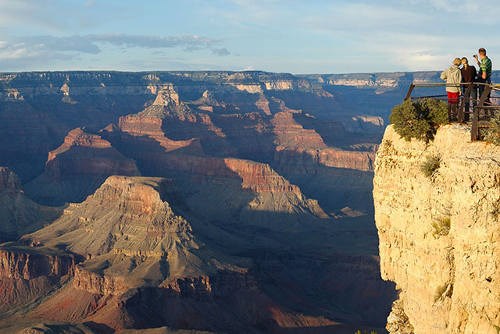
Hermit Road: Need to Know
Along the canyon rim are 9 designated viewpoints. These viewpoints are described on the page and all have shuttle bus stops. Photos From Hermit Road Overlooks
Transfer Station0.7 miles, (1.1 km) west from here to Trailview Overlook(paved trail) The Hermits Route (Red) shuttle begins here, at the Hermit Road Transfer Station, and ends at Hermits Rest. On the other side of the barricade is the Village Route (Blue) shuttle stop. The Rim Trail also begins here. From the transfer station, the trail climbs a hill to Trailview Overlook. The hill was created by the Bright Angel Fault, and is one of the steepest sections of the Rim Trail. But the views along the way are worth the climb! 
Trailview Overlook0.7 miles, 1.1 km west from here to Maricopa Point on paved trail0.7 miles, 1.1 km east from here to Hermits Rest Transfer on a paved trail This viewpoint offers good views of the Bright Angel Trail switchbacking through the canyon below, as well as the Historic District of the village, including the prominent El Tovar Hotel. Several sets of stairs access two main viewing areas. 
Maricopa Point0.5 miles, 0.8 km west from here to Powell Point on paved and then dirt trail In addition to stunning vistas, Maricopa Point looks out over the former Orphan Lode Mine, claimed in 1891 by miner Dan Hogan. Originally mining copper, Hogan switched to uranium ore in the 1950s. Mining operations ended in 1967. Grand Canyon National Park acquired the property in 1987 but only began major environmental restoration in 2008 
Powell Point0.3 miles, 0.5 km west from here to Hopi Point on dirt trail The Powell Memorial at this viewpoint commemorates the 1869 and 1871-72 exploratory trips down the Colorado River by Major John Wesley Powell and expedition crews. Stunning vistas can also be enjoyed from Powell Point. 
Hopi Point0.8 miles, 1.3 km west from here to Mohave Point on dirt trail Hopi Point is one of the most popular viewpoints for watching the sunset and sunrise because of its wide vistas. The Colorado River comes into view to the west. Restrooms are available here. 
Mohave Point1.1 miles, 1.8 km west from here to The Abyss on dirt trail Another spectacular point for watching sunset and sunrise, Mohave Point also offers views of the Colorado River deep in the canyon below. 
The Abyss0.9 miles, 1.4 km west from here to Monument Creek Vista on dirt trail This viewpoint provides an almost vertical view down into the canyon, looking down into the Monument Creek drainage area where backpackers often camp next to Monument Creek or on a small beach along the Colorado River at Granite Rapids. 
Monument Creek Vista1.7 miles, 2.7 km west from here to Pima Point on paved trail From this viewpoint the Greenway Trail begins, accommodating hikers, bicyclists, and visitors using wheelchairs. The trail meets Accessibility Guidelines for Outdoor Developed Areas. Much of the trail follows the 1912 alignment of Hermit Road. There are six overlooks, including Pima Point, in addition to multiple resting areas along the trail. 
Pima Point1.1 miles, 1.8 km west from here to Hermits Rest on paved trail Pima Point is one of the best places on the rim to see and sometimes hear the river. The splash and grind of Granite Rapids below can be heard echoing up the canyon walls on quiet days. The Greenway Trail continues from here to Hermits Rest, allowing bicyclists and visitors using wheelchairs to share the path with pedestrians. 
Hermits RestRim Trail ends to the west Mary Colter, one of Grand Canyon's most famous architects, built Hermits Rest in 1914 to look like an old miner's cabin, complete with a giant fireplace and front porch. Today Hermits Rest has a gift shop and small snack bar. Restrooms are available here. The Hermit Trail, winding steeply down into the canyon, begins about 0.5 miles, 0.8 km west of Hermits Rest. South Rim Shuttle Bus Route Map

2008 Road RehabilitationIn November 2008 a major rehabilitation project was completed along Hermit Road that included widening the road to increase visitor safety, widening and improving the rim trail and constructing a new multi-use Greenway Trail, while maintaining the historic rural character of the roadway and protecting the park’s natural and cultural resources. |
Last updated: November 30, 2025
